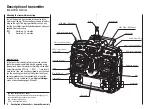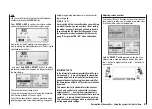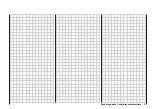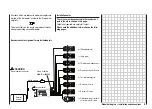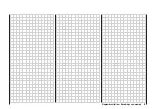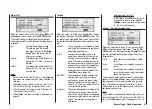
24
Defi nition of terms
Control functions, transmitter controls, function inputs, control channels, mixers, switches, control switches
To make it easier for you to understand the mx-16s ma-
nual, the following two pages contain defi nitions of many
terms which crop up again and again in the remainder of
the text, together with a basic fl ow diagram showing the
course of the signal from the transmitter control to the
point at which it is radiated from the transmitter aerial.
Control function
The term “control function” can be thought of as the sig-
nal generated for a particular function which needs to be
controlled – initially independent of its subsequent pro-
gress through the transmitter. In the case of fi xed-wing
model aircraft the control functions include throttle, rud-
der and aileron, whereas collective pitch, roll-axis and
pitch-axis are typical of those used for helicopters. The
signal of a control function may be assigned directly, or
to several control channels simultaneously via mixers.
A typical example of the latter is separate aileron ser-
vos, or pairs of roll-axis or pitch-axis servos in a model
helicopter. The essential feature of a control function is
its infl uence on the mechanical travel of the correspon-
ding servo.
Transmitter control
The term “transmitter control” is used for the mechani-
cal elements on the transmitter which are operated di-
rectly by the pilot. Their movements in turn generate cor-
responding movements in the servos, speed controllers
etc. at the receiver end. The transmitter controls include
the following:
•
The two dual-axis stick units for the control functions
1 to 4; these four functions can be interchanged in
any way you like through software, e.g. throttle left
or right, without having to re-connect the servos; this
applies to both fi xed-wing model aircraft and helicop-
ters. The dual-axis stick function for throttle (or airbra-
kes) is often referred to as the C1 (Channel 1) cont-
rol.
• The rotary proportional control fi tted at top left (CTRL
7)
•
The INC / DEC buttons (CTRL 5 + 6) located on eit-
her side of the aerial base.
•
Switches SW 1 … .8, if they have been assigned to a
control channel in the “Control settings” menu.
When a proportional transmitter control is operated, the
servo or servos follow the position of the control direct-
ly, whereas a switched channel provides just the two or
three set servo positions.
Function input
This is an imaginary point in the signal path, and must
not be considered the same as the point on the circuit
board where the transmitter control is connected! The
two menus »
Stick mode
« and »
Control settings
« af-
fect the course of the signal “after” these points, and it
is possible (and likely) that there will be differences bet-
ween the number of the transmitter control (as stated
above) and the number of the subsequent control chan-
nel.
Control channel
There is a point in the signal path where the signal con-
tains all the control information required for a particular
servo – this may be directly generated by a transmitter
control or indirectly via a mixer – and from this point on
we call the signal a control channel. This signal is speci-
fi c to an individual servo, and is only affected by any ad-
justments carried out in the “Servo settings” menu be-
fore leaving the transmitter via the RF module in order to
actuate the corresponding servo in the model.
Mixer
In the signal fl ow diagram you will see a wide range of
mixer functions. Their purpose is to enable a control
function to affect multiple servos at the branching point
of the mixer input; the range of mixer programs is extre-
mely wide-ranging. For more information please refer to
the numerous mixer functions as described in the sec-
tion starting on page 61 of the manual.
Switch
The three standard switches SW 1 … 3, the three-posi-
tion switch SW 6/7 and the momentary buttons SW 4 /
PB 8 can also be incorporated into the programming of
the transmitter controls. However, all these switches are
also capable of controlling various program options, e.g.
starting and stopping timers, switching mixers on and
off, transferring control in Trainer mode etc. Each phy-
sical switch function can be assigned to as many func-
tions as you wish.
Numerous examples are described in the manual.
Transmitter control switch
It is often desirable to switch a function on or off auto-
matically at a particular position of another transmitter
control, e.g. at a defi ned position of one of the dual-axis
sticks. Typical examples are switching a stopwatch on
and off to allow you to record the motor run time, exten-
ding spoilers automatically (and many others). The pro-
gram of the mx-16s includes a total of two (or three – for
helicopters) “control switches” of this type.
Two transmitter control switches are available for the C1
stick in each model memory, both for fi xed-wing model
aircraft and helicopters. For helicopters a third is present
in the form of the throttle limiter; see pages 25 and 54.
This manual includes a range of instructive examples
which make programming as simple as child’s play. Ple-
ase refer to the programming examples in the section
starting on page 84.
Description of transmitter – Defi nition of terms
Содержание MX-16S
Страница 1: ...1...
Страница 17: ...17...
Страница 31: ...31 Fixed wing models Installation and connections...
Страница 35: ...35 Program description Reserving a new memory...
Страница 47: ...47 Base settings Model helicopter...
Страница 83: ...83 Fail safe...
Страница 89: ...89 Programming examples Fixed wing model...
Страница 109: ...109 Programming examples Model helicopter...
Страница 112: ...112 112...
Страница 116: ...116...





